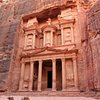
Apr 25th, 2020
The best-known attraction among the ruins of Aspendos is the great theater, an amazingly well preserved vestige of Roman architecture that may be as impressive as Rome's own Colosseum.
Show more...

The city of Aspendos has very ancient roots, going back at least as far as the 5th century BCE by which time it was a firmly established Greek colony, perhaps settled by people from Argos on the Peloponnese. At that time it was the chief city in Pamphylia until the usual chain of events began to unfold. The Persians took over in 546 BCE, Cimon liberated the city in 465 BCE and it joined the Delian League. The Persians were back in control by 411 BCE.
In 333 BCE Alexander the Great ended Persian domination in Anatolia once and for all. In 190 BCE the Romans took over and Aspendos enjoyed a long period of prosperity under Pax Romana until it gradually faded away under Byzantine rule and by the Middle Ages was pretty well abandoned.
However, while the city crumbled to dusty ruins, one great edifice withstood the corrosive effects of time and that was the magnificent theatre, the best preserved in the ancient world.
It was built under the rule of the great emperor Marcus Aurelius in the 2nd century by an architect named Zenon and built so well that the Seljuk Turks used it as first a caravansary and then a palace. Today it is the host of the annual International Opera and Ballet Festival which attracts some of the best opera singers and ballet performers in the world.
Aspendos is only 49 kms. (30 miles) from Antalya, but with much of it through the outskirts of the city it takes us almost an hour to get there.
The first thing that makes Aspendos so different than the theatres I have seen in Ephesus, Pergamon and Myra.is that its exterior entrance is still fully intact. This is the part that was used as both a caravansary and a palace. I have seen a lot of ancient theatres, but I have never seen one like this.
Passing through the entrance you come upon the theatre itself and trust me, it's a 'just WOW' moment.
You need to climb up to the top where there is a covered colonnade to get the view toward the stage. Once again I have to marvel at the genius of the architect who could build a structure of this size and yet get the acoustic so right that even from this distance you can plainly hear the performers on stage. I know this because our guide demonstrated it.
There is a representation of the goddess of good fortune Tykhe above the stage which was common in Roman era theatres. She certainly did bring good fortune to this building that has stood for 1,800 years.

Like, how many of these places have you seen so great, so big, so old and so well preserved? I don't get how can people rate this place 3 out of 5? Commenting on the previous review.
Aspendos theater is one of the largest ever built by the Romans in Asia Minor, and today it is one of the best preserved examples of Roman theater architecture. It is imposing, in an incredible shape, magnitude and condition. Simply impressing. Acoustic is stunning, they are actually have concerts here, the stage you see in the pictures is not genuine, it is wood made covered in stone looking panels.
You cant miss this if you are inspired by history and ancient architecture, you just cant! Visited on March 23 at 10:00 AM. Entrance fee is 60 TL ($5), ticket attached.
We have visited various historical sites in the Antalya region and can say that the Aspendos amphitheater is the best preserved. This is a wonderful place for cultural enlightenment and walking through the archaeological monuments of the ancient city. I note that most of the city and its facilities are located on a hill, where not everyone goes. If you have baby strollers, then unfortunately you couldn't go to the aqueduct, you should take a baby stretcher.
Show more...
An excellent example of a Roman theatre, reputed to be one of the most complete in an unrestored original state with few repairs done. Those restorations that have been carried out are in the style which matches but makes it obvious so you can see how much of the original remains. Quite steep terracing compared to the many we have seen on our month in Turkey. A stunning piece of architecture worth the entrance price on its own. Which is just as well as the rest of the site is unrestored, overgrown and with uneven rocky paths with not a great deal to see.
Show more...Impressive well preserved Roman amphitheater still used today for concerts as it has incredible acoustics. It was a long coach ride from Antalya port but worth the time and effort. Would have liked to have toured the ruins of the ancient aqueduct and Roman bridge in the same area but time was tight as we were scheduled to visit the impressive Side archeological site the same day.
Show more...
If you are a history buff like me, it is an ancient region that should definitely be on your bucket list. The acoustics in this theater built centuries ago are so good that you can hear the conversations from the top floor without any difficulty. The fact that people fought here once, the cellars that came out of the movies are mystical and impressive. I can say this is a good build. I highly recommend it.
Show more...Aspendos. The theatre is the best preserved Roman theatre in Turkey; some say in the world. Inscriptions show that it was built between 138 and 164 AD. It was renovated in the 1500s when it was part of a Seljuk palace. There is seating 12000 people. The stage area is restored to its full towering glory. The covered area at the top of the theatre and the passage ways below show both the great size and intricate detail of the build. Productions of plays and music concerts restarted in 1959.
Beyond the theatre rough paths lead to other parts of the city and then the magnificent aqueduct comes into view. Many parts remain intact and show the route water came to the city from nearby mountains.
Many people only see the theatre but there are many other buildings to see including a stadium. The view from the hill above the theatre is spectacular with the theatre in the foreground and the mountains as a back drop.
Aspendos is signposted from the main D400 coast road which is a short distance away. The route passes a Roman bridge. There is a large car park with an adjacent cafe and modern toilet facilities. Many of the paths are uneven, and the steps in the theatre are steep and often slippery.

Aspendos is famous for its well preserved Roman amphitheater which seats 12000 guests was built during the time of the Roman Empire. It is still being used today for concerts and other events. Supposedly this was a competition between two brothers. One brother built the amphitheater and another brother built the 25 kilometer aqueducts. Unlike the amphitheater, only remnants of aqueduct remain.
Show more...We visited the Aspendos Theatre dating from the 2nd century AD (the best preserved theater in the ancient world) built during the reign of Marcus Aurelius. It hosts 12 K and still has near-perfect acoustics for plays & operas. We were there while a crew was setting up the night before a rock concert.
Show more...Hotels near Aspendos Ruins:
Restaurants near Aspendos Ruins:
Attractions near Aspendos Ruins:
When we're travelling in Turkey, we could see quite a few ruins of ancient theater.
Show more...Some of them were made by the Greek, and some other were made by the Romans.
This ancient theater was build by Roman Empire.
We can also see ruins of Romans aquaduct on our way to Aspendos.
The theater was well preserved. However, please be mindfull of steep and chipped flaight of stairs if you are travelling with you children or elderly people.